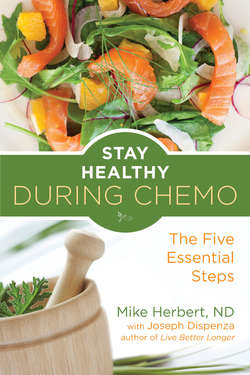Читать книгу Stay Healthy During Chemo - Джо Диспенза - Страница 15
На сайте Литреса книга снята с продажи.
The Other Part of Healing
ОглавлениеAs we have seen, chemotherapy is only a part of the healing scenario for a cancer patient. Certainly, it is an essential element for those who have chosen a conventional route to treat cancer. But, while chemo is a powerful attacker of cancer cells, it is not a cure-all for the disease.
The other part of healing from cancer is the challenge of staying healthy through the span of chemo treatments and remaining in good health after those treatments have run their course. It is no small challenge for the cancer patient, particularly in the run-down physical and emotional state left in the wake of the chemo drugs.
What is required to stay healthy is, in the first place, a willingness to engage in the healing process. Many cancer patients simply turn their healing program over to their oncologist and assume that the doctor will take care of everything necessary to return to good health. This is the doctor-as-garage-mechanic attitude: I take my body into the shop, the doctor fixes it, and I go home. It is a mistake that could be fatal—and sometimes is literally that for thousands of people with cancer.
In our culture, we might even say that the role of the doctor has less to do with creating good health than in managing disease. We ask an oncologist to treat our cancer, but that does not automatically mean that we are asking the doctor to restore us to vibrant well-being. In fact, with our medical system of disease management (as opposed to health fostering), it actually would be presumptuous of us to expect more of our physicians than what they offer. And what they offer is considerable, if we want to eradicate cancer from the body.
Engaging the process of healing means that we do not rely on doctors alone to give us good health. They do their part by trying sincerely to rid the body of a rapidly growing disease. The rest is up to the cancer patient. This is not an easy thing to commit to, but unless one does, there can be no real healing.
So, what does the cancer patient do to fill in the blanks left by a system that goes only as far as managing the disease—in this case, destroying cancer and removing it from the body?
First, as I said earlier, is to decide to undertake one's own healing and not assume that a doctor or a nurse or a hospital staff member is going to do it; they won't because that is not what they do, it's not their job.
Next is to try to get as much information as possible—good, reliable, authoritative information—to form a structure for a healing program. I am writing this book to help provide just that.
Finally, a cancer patient will need to have a dedicated caregiver. This is so important that I am going to say more about it in a separate section that follows. All the good resolutions a person with cancer makes will come to naught without the help of someone who is physically and mentally on top of things.
